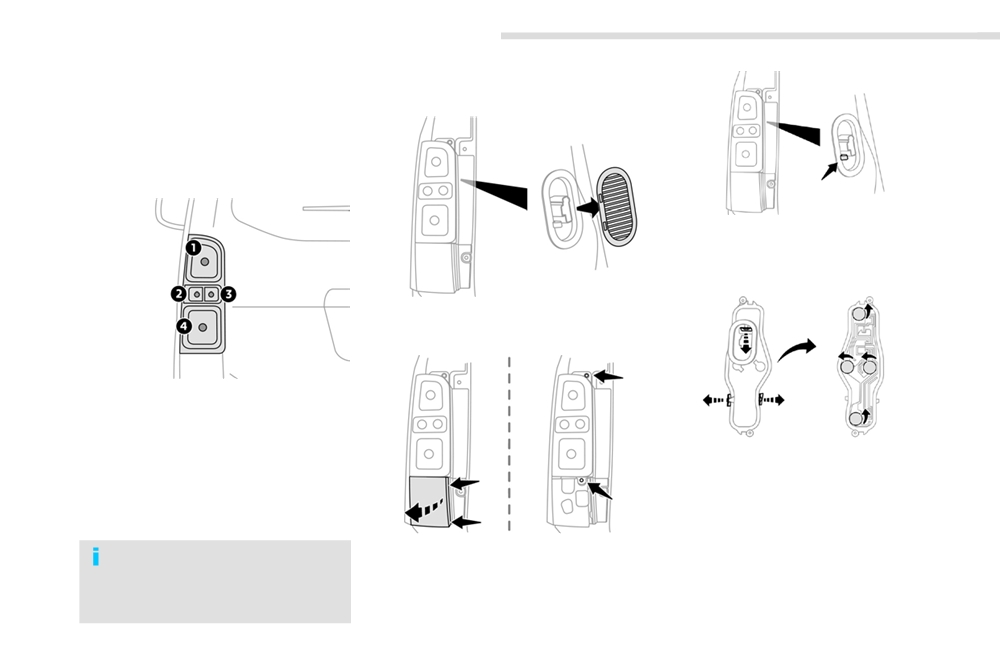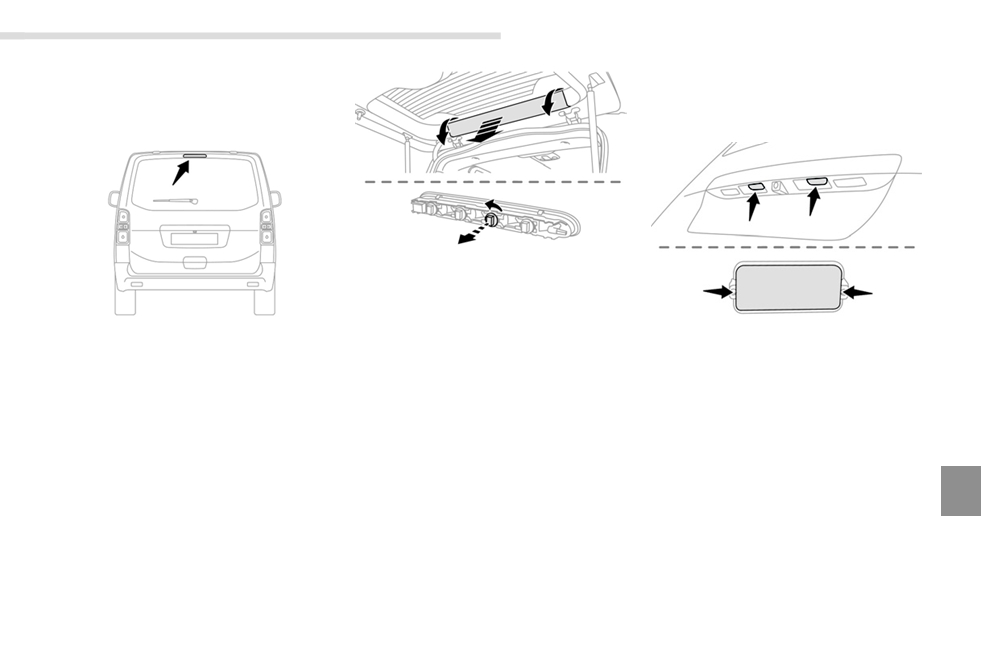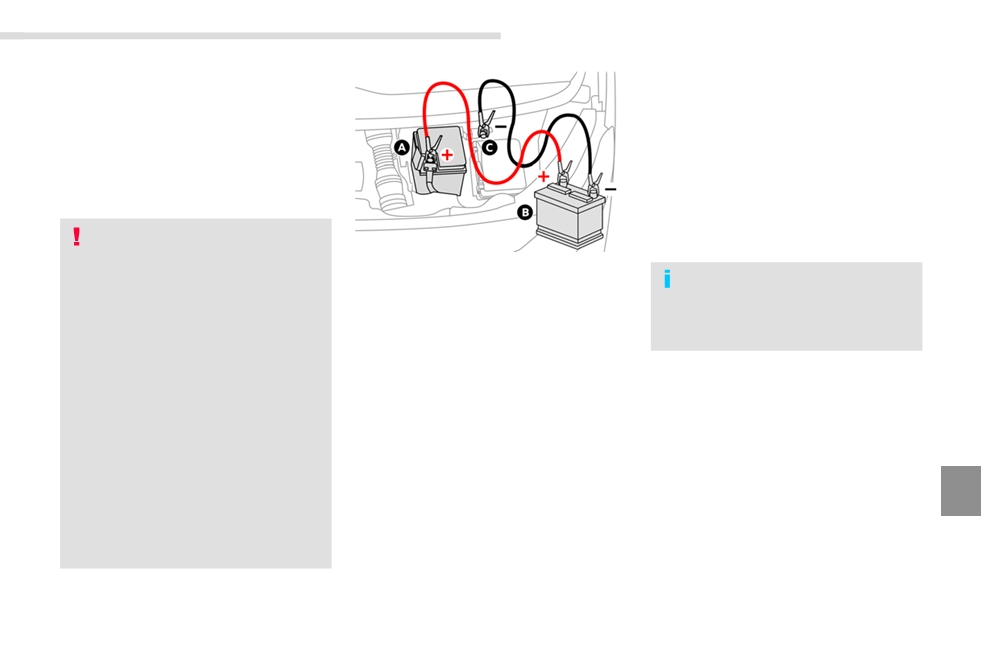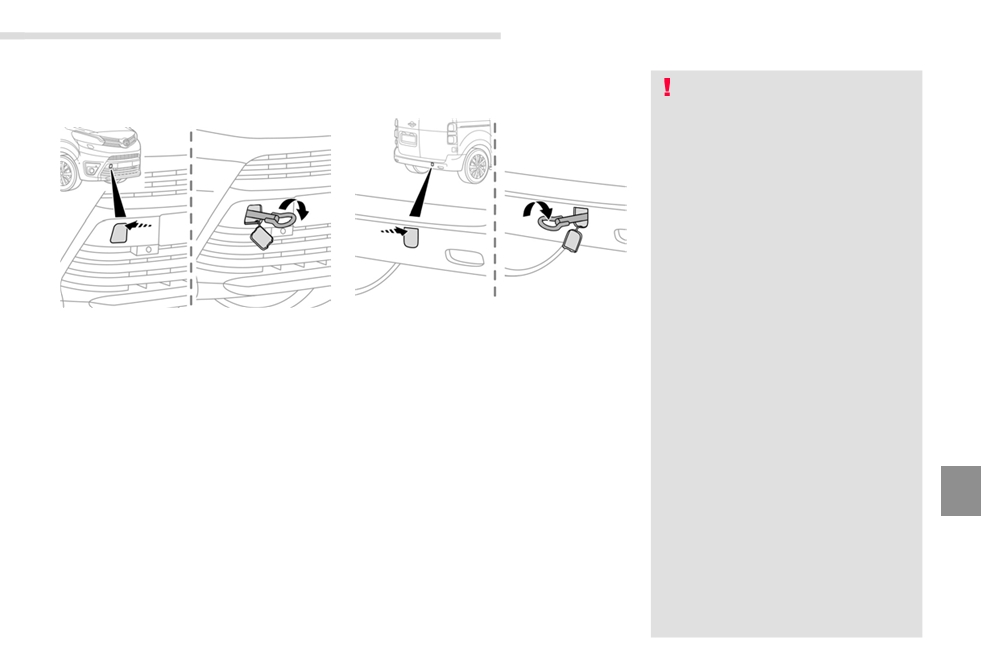Toyota ProAce Verso (2017 year). Instruction — part 19

In the event of a breakdown
Third brake lamp
Number plate lamps
(rear wing doors with glass
(rear wing doors with glass
windows)
windows)
Type A, W5W-5W
Type A, W5W-5W
F Remove the plastic cover using a small
screwdriver.
F Using a screwdriver through the aperture,
push the lamp towards the outside.
F Open the left hand rear door.
F Insert a thin screwdriver into one of the
F Disconnect the electrical connector.
cut-outs in the lens.
F Remove the lamp.
F Push it outwards to unclip it.
F Turn the bulb holder a quarter turn anti-
F Remove the lens.
clockwise.
F Change the failed bulb.
F Change the failed bulb.
To refit, press on the lamp to clip it in place.
To refit, press on the lens to clip it in place.
306

In the event of a breakdown
Courtesy lamps
(front and rear)
Type A, W5W-5W
F Unclip the lens by inserting a thin
screwdriver into the cut-outs at each side
of the lamp.
F Pull the bulb out and change it.
F Clip the lens in place and ensure that it is
secure.
8
307

In the event of a breakdown
F Identify the failed bulb then open the boot.
Rear lamps
(rear tailgate)
For more information on Changing a bulb and
in particular, the types of bulbs, refer to the
corresponding section.
F While holding the lamp in place, press the
clip on the inside then carefully remove the
lamp.
F Disconnect the electrical connector.
F From inside, remove the cover, if your
vehicle has one.
1. Brake lamps / sidelamps.
Type B, P21/5W-21/5W.
2. Direction indicators.
Type B, PY21W-21W (amber)
F Spread the three lugs slightly, then extract
3. Reversing lamps.
the bulb holder.
Type B, P21W-21W
F Remove the failed bulb by pressing
4. Foglamps / sidelamps.
lightly on it, then turning it a quarter turn
Type B, P21/4W-21/4W.
clockwise.
F Change the bulb.
F From the outside, press on the inner clips
For vehicles with interior trim, contact
on the plastic finisher then tip it towards the
an authorized Toyota dealer or repairer,
outside to remove it.
To reassemble, carry out these operations in
or another duly qualified and equipped
F Unscrew the two lamp fixing screws.
reverse order.
professional to have the work done.
308

In the event of a breakdown
Third brake lamp
Number plate lamps
(rear tailgate)
(rear tailgate)
Type A, W5W-5W
Type A, W5W-5W
F Unclip the trim at each end by turning it
upwards.
F Pull on the trim to disengage the central
clips, then remove it.
F Using a screwdriver through the aperture,
F Open the rear tailgate.
F Insert a thin screwdriver into one of the cut-
push the lamp towards the outside.
outs in the lens.
F Disconnect the electrical connector.
F Push it outwards to unclip it.
F Remove the lamp.
F Remove the lens.
F Turn the bulb holder a quarter turn anti-
F Change the failed bulb.
clockwise.
F Change the failed bulb.
To refit, carry out these operations in reverse
To refit, press on the lens to clip it in place.
order.
8
To refit the lamp and trim, press on them to clip
them in place.
309

In the event of a breakdown
Courtesy lamps
(front and rear)
For the replacement of this type of LED lamp
and light guide, contact an authorized Toyota
dealer or repairer, or another duly qualified and
equipped professional.
A replacement kit for the LEDs is available from
Toyota dealers.
310

In the event of a breakdown
Changing a fuse
Access to the tools
Changing a fuse
Before changing a fuse:
F the cause of the failure must be identified
and rectified,
F all electrical consumers must be
switched off,
F the vehicle must be immobilised with the
ignition off,
Good
Failed
F identify the failed fuse using the tables and
layout drawings in the following pages.
The extraction tweezer is located behind the
To replace a fuse, you must:
fusebox cover, on the dashboard pillar.
F use the special tweezer to extract the fuse
from its housing and check the condition of
Tweezer
its filament.
F Unclip the cover by pulling at the top left,
F always replace the failed fuse with a fuse
then right.
of the same rating (same colour); using a
F Disengage the cover completely and turn it over.
different rating could cause faults (risk of
F Take the tweezer from its housing.
fire).
If the fuse fails again soon after replacement,
The replacement of a fuse not shown in
have the vehicle's electrical system checked
the tables below may cause a serious
by an authorized Toyota dealer or repairer,
8
malfunction of your vehicle. Contact an
or another duly qualified and equipped
authorized Toyota dealer or repairer,
or another duly qualified and equipped
professional.
professional.
311

In the event of a breakdown
Dashboard fuses
Installing electrical
accessories
Your vehicle's electrical system is
The fusebox is placed in the lower dashboard
designed to operate with standard or
(left-hand side).
optional equipment.
Before installing other electrical
equipment or accessories on your
Access to the fuses
vehicle, contact an authorized Toyota
dealer or repairer, or another duly
qualified and equipped professional.
Toyota will not accept responsibility
for the cost incurred in repairing your
vehicle or for rectifying malfunctions
resulting from the installation of
accessories not supplied and not
recommended by Toyota and not
installed in accordance with its
instructions, in particular when the
F Unclip the cover by pulling at top left, then
combined consumption of all of the
right.
additional equipment connected
exceeds 10 milliamperes.
For more information on installing a
towbar or equipment of the TAXI type,
contact a Toyota dealer.
312

In the event of a breakdown
Version 1 (Eco)
Fuse
Rating
Functions
The fuses described hereafter vary according
N°
(A)
to the equipment in your vehicle.
F1
10
Electric power steering, clutch switch
F4
15
Horn.
F5
20
Front/rear screenwash pump.
F6
20
Front/rear screenwash pump.
F7
10
Rear 12 V accessory socket.
F8
20
Single or double rear wipers.
F10/F11
30
Front and rear, exterior, interior locks.
Front air conditioning controls, radio controls, gear lever,
F13
10
head-up display.
F14
5
Alarm, ERA-GLONASS emergency call system.
F17
5
Instrument panel.
F19
3
Steering mounted controls.
F21
3
Smart Entry & Start System or ignition switch.
F22
3
Rain and sunshine sensor, multifunction detection camera.
F23
5
Seat belt unfastened or not fastened display screen.
F24
5
Touch screen, reversing camera and parking sensors.
F25
5
Airbags.
F29
20
Audio system, touch screen, CD player, navigation.
F31
15
Audio system (battery +).
8
F32
15
Front 12 V accessory socket.
F34
5
Blind spot monitoring system, door mirror electric controls.
F35
5
Heated washer jets, headlamp beam height control.
F36
5
Torch charger, rear courtesy lamp.
313

In the event of a breakdown
Version 2 (Full)
Fuse
Rating
Functions
N°
(A)
The fuses described hereafter vary according
F1
3
Smart Entry & Start System or ignition switch.
to the equipment in your vehicle.
F5
5
Touch screen, reversing camera and parking sensors.
F7
10
Rear air conditioning controls, Hi-Fi amplifier.
F8
20
Single or double rear wiper.
F10/F11
30
Front and rear, exterior, interior locks.
F12
3
Alarm.
F17
10
Rear 12 V accessory socket.
F18
5
ERA-GLONASS emergency call system.
F21
3
Torch charger, rear courtesy lamp.
F22
3
Glove box lamp, rear courtesy lamps.
F23
5
Blind spot monitoring system, door mirror electric controls.
F24
5
Steering mounted controls.
F25
5
Headlamp beam height control.
F26
3
Seat belt unfastened or not fastened display screen.
F27
3
Rain and sunshine sensor, multifunction detection camera.
Front air conditioning controls, radio controls, gear lever, head-
F28
10
up display.
F30A or B
15
Audio system (battery +).
F31
5
Airbags.
F33
15
Front 12 V accessory socket.
F35
5
Instrument panel.
F36
20
Audio system, touch screen, CD player, navigation.
314

In the event of a breakdown
The fuses described hereafter vary according to the equipment in your vehicle.
Engine compartment fuses
Fuse
Rating
Functions
The fusebox is located in the engine
N°
(A)
compartment near the battery.
F12
5
Heated washer jets.
F14
25
Front and rear screenwash pump.
Access to the fuses
F15
5
Front radar and emergency braking, electric power steering.
F17
10
Built-in systems interface.
F19
30
Front wiper motor.
F20
15
Front and rear screenwash pump.
F21
20
Headlamp wash pump.
F22
15
Horn.
F23
15
Right hand main beam headlamp.
F Release the two latches A.
F24
15
Left hand main beam headlamp.
F Remove the cover.
F Change the fuse.
F When you have finished, close the cover
carefully then engage the two latches A, to
ensure correct sealing of the fusebox.
8
315

In the event of a breakdown
Access to the battery
12 V battery
The battery is located under the bonnet.
Procedure for starting the engine using another
F Open the bonnet using the interior release
battery or charging a discharged battery.
lever, then the exterior safety catch.
F Secure the bonnet stay.
General points
Lead-acid starter batteries
Batteries contain harmful substances
Protect your eyes and face before
such as sulphuric acid and lead.
handling the battery.
They must be disposed of in
All operations on the battery must be
accordance with regulations and must
carried out in a well ventilated area and
not, in any circumstances, be discarded
away from naked flames and sources
with household waste.
of sparks, so as to avoid the risk of
Take used remote control batteries and
explosion or fire.
F Remove the plastic cover on the (+) terminal.
vehicle batteries to a special collection
Wash your hands afterwards.
The battery (-) terminal is not accessible.
point.
A remote earth point is provided at the front of
the vehicle.
Versions equipped with Stop & Start are
If your vehicle has an automatic
For more information on the
fitted with a 12 V lead-acid battery of
gearbox, do not try to start the engine
Bonnet and the Engine, refer to the
specific technology and specification.
by pushing the vehicle.
corresponding section(s).
Its replacement should be carried out
only by an authorized Toyota dealer or
repairer, or another duly qualified and
equipped professional.
316

In the event of a breakdown
F
Wait until the engine returns to idle then
Starting using another
disconnect the jump lead cables in the
battery
reverse order.
When your vehicle's battery is discharged, the
F
Refit the plastic cover to the (+) terminal, if
engine can be started using a slave battery
your vehicle has one.
(external or on another vehicle) and jump lead
F
Allow the engine to run for at least
cables or a battery booster.
30 minutes, by driving or with the vehicle
stationary, so that the battery reaches an
adequate state of charge.
Never try to start the engine by
connecting a battery charger.
Never use a 24 V or higher battery
F
Raise the plastic cover on the (+) terminal,
Some functions, including Stop & Start,
booster.
if your vehicle has one.
are not available if the battery is not
First check that the slave battery has a
F
Connect the red cable to the positive
sufficiently charged.
nominal voltage of 12 V and a capacity
terminal (+) of the flat battery A (at
at least equal to that of the discharged
the metal elbow) then to the positive
battery.
terminal (+) of the slave battery B or the
The two vehicles must not be in contact
booster.
with each other.
F
Connect one end of the green or black
Switch off the electrical consumers on
cable to the negative terminal (-) of the
both vehicles (audio system, wipers,
slave battery B or the booster (or earth
lighting, ...).
point on the other vehicle).
Ensure that the jump lead cables do
F
Connect the other end of the green or black
not pass close to moving parts of the
cable to the earth point C on the broken
engine (cooling fan, belts, ...).
down vehicle.
Do not disconnect the (+) terminal when
F
Start the engine of the vehicle with the
8
the engine is running.
good battery and leave it running for a
few minutes.
F
Operate the starter on the broken down
vehicle and let the engine run.
If the engine does not start straight away,
switch off the ignition and wait a few moments
before trying again.
317

In the event of a breakdown
F
Connect the charger B cables as follows:
Charging the battery using
Follow the instructions for use provided
- the positive (+) red cable to the
a battery charger
by the manufacturer of the charger.
(+) terminal of the battery A,
Never reverse polarities.
For optimum service life of the battery, it is
- the negative (-) black cable to the earth
essential to maintain an adequate state of
point C on the vehicle.
charge.
F
At the end of the charging operation, switch
It is not necessary to disconnect the
In some circumstances it may be necessary to
off the charger B before disconnecting the
battery.
charge the battery:
cables from the battery A.
-
if you use your vehicle essentially for short
journeys,
-
if the vehicle is to be taken off the road for
F
Switch off the ignition.
several weeks.
F
Switch off all electrical consumers (audio
Contact an authorized Toyota dealer or
system, lighting, wipers, ...).
repairer, or another duly qualified and equipped
Never try to charge a frozen battery.
professional.
If the battery has been frozen, have it
If you envisage charging your vehicle's
checked by an authorized Toyota dealer
battery yourself, use only a charger
or repairer, or another duly qualified and
compatible with lead-acid batteries of a
equipped professional, who will check
nominal voltage of 12 V.
that the internal components have not
been damaged and the casing is not
cracked, which could cause a leak of
toxic and corrosive acid.
If this label is present, it is essential
F Switch off the charger B before connecting
to use only a 12 V charger, to avoid
the cables to the battery, so as to avoid any
causing irreversible damage to the
dangerous sparks.
electrical components related to the
F Ensure that the charger cables are in good
Stop & Start system.
condition.
F Raise the plastic cover, if your vehicle has
one, on the (+) terminal.
318

In the event of a breakdown
Disconnecting the battery
Quick release terminal
Following reconnection of the battery
After reconnecting the battery, switch on the
ignition and wait 1 minute before starting to
In order to maintain an adequate state
allow initialisation of the electronic systems.
of charge for starting the engine, it is
However, if minor problems persist following
recommended that the battery be disconnected
this operation, contact an authorized Toyota
if the vehicle is taken out of service for a long
dealer or repairer, or another duly qualified and
period.
equipped professional.
Wait 2 minutes after switching off the ignition
Referring to the corresponding section, you
before disconnecting the battery.
must yourself reinitialise or reset certain
F close the windows and the doors before
systems, such as:
disconnecting the battery,
-
the remote control or electronic key
F switch off all electrical consumers (audio
Disconnecting the (+) terminal
(depending on version),
system, wipers, lighting, ...),
-
the electric windows,
F switch off the ignition and wait for
F Raise the lever A fully to release the
-
the date and time,
four minutes.
clamp B.
-
the radio preset stations.
Having exposed the battery, it is only
necessary to disconnect the (+) terminal.
Reconnecting the (+) terminal
F Position the open clamp B of the cable on
The Stop & Start system may not be
the positive post (+) of the battery.
operational during the trip following the
F Press down on the clamp to position it
first engine start.
correctly on the battery post.
In this case, the system will only be
F Lock the clamp by lowering the lever A.
available again after a continuous
period of immobilisation of the vehicle,
a period which depends on the ambient
8
temperature and the state of charge of
Do not force the lever as locking will
the battery (up to about 8 hours).
not be possible if the clamp is not
positioned correctly; start the procedure
again.
319

In the event of a breakdown
Battery capacity
If your vehicle is fitted with a manual
Towing
gearbox, put the gear lever into neutral.
Procedure for having your vehicle towed or
Rating in Ah
Vehicle length
for towing another vehicle using a removable
(Ampere hours)
towing eye.
If your vehicle has an automatic or
Compact (L0)
480
electronic gearbox, place the gear
selector at position N.
Standard (L1)
640
Access to the tools
Long (L2)
720 / 800
The failure to observe this special point
may lead to damage to components
of the braking system and the lack of
braking assistance on restarting the
Always replace the battery by one of
engine.
equivalent specification.
The towing eye is stowed in the tool box.
For more information on the Tool box,
refer to the corresponding section.
320

In the event of a breakdown
Towing your vehicle
Towing another vehicle
General
recommendations
Observe the legislation in force in your
country.
Ensure that the weight of the towing
vehicle is higher than that of the towed
vehicle.
The driver must remain at the wheel of
the towed vehicle and must have a valid
driving licence.
When towing a vehicle with all four
wheels on the ground, always use an
approved towing arm; rope and straps
are prohibited.
F
On the rear bumper, press the cover (as
F
On the front bumper, press the cover (as
The towing vehicle must move off gently.
shown above) to unclip it.
shown above) to unclip it.
When towing a vehicle with the engine
F
Screw the towing eye in fully.
F
Screw the towing eye in fully.
off, there is no longer any power
F
Install the towing arm.
F
Install the towing arm.
assistance for braking or steering.
F
Switch on the hazard warning lamps on the
F
Switch on the hazard warning lamps on the
In the following cases, you must always
towed vehicle.
towed vehicle.
call on a professional recovery service:
F
Move off gently and drive slowly over a
F
Move off gently and drive slowly over a
-
vehicle broken down on a motorway
short distance only.
short distance only.
or fast road,
-
four-wheel drive vehicle,
-
when it is not possible to put the
gearbox into neutral, unlock the
8
steering, or release the parking
brake,
-
towing with only two wheels on the
ground,
-
where there is no approved towing
arm available...
321

In the event of a breakdown
Running out of fuel (Diesel)
On vehicles fitted with Diesel engines, the fuel
1.6 D engine
AdBlue engine
system must be primed if you run out of fuel.
(except AdBlue)
F Fill the fuel tank with at least five litres of
For all versions other than with AdBlue, refer to
Diesel.
the corresponding engine compartment view.
F Switch on the ignition (without starting the
engine).
F Wait around 6 seconds and switch off the
ignition.
F Repeat the operation 10 times.
F Operate the starter to run the engine.
For more information on Diesel misfuel
F
Add at least five litres of Diesel fuel to the
prevention, refer to the corresponding
tank.
section.
F
Open the bonnet.
Other engines
F
If necessary, unclip the styling cover for
F
Add at least five litres of Diesel fuel to the
access to the priming pump.
tank.
F
Squeeze and release the priming pump
F
Open the bonnet.
repeatedly until resistance is felt (there
If the engine does not start first time,
F
If necessary, unclip the styling cover for
may be resistance at the first press).
don't keep trying but start the procedure
access to the priming pump.
F
Operate the starter to start the engine
again from the beginning.
F
Squeeze and release the priming pump
(if the engine does not start at the first
repeatedly until resistance is felt (there
attempt, wait around 15 seconds before
may be resistance at the first press).
trying again).
F
Operate the starter to start the engine
F
If the engine does not start after a few
(if the engine does not start at the first
attempts, operate the priming pump again
attempt, wait around 15 seconds before
then start the engine.
trying again).
F
Refit the styling cover and clip it in place.
F
If the engine does not start after a few
F
Close the bonnet.
attempts, operate the priming pump again
then start the engine.
F
Refit the styling cover and clip it in place.
F
Close the bonnet.
322
Большое спасибо!
Ваше мнение очень важно для нас.

Нет комментариевНе стесняйтесь поделиться с нами вашим ценным мнением.
Текст